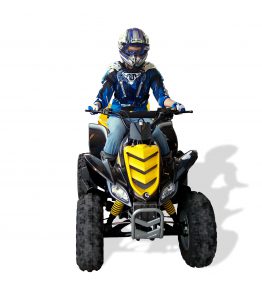Did you know that all-terrain vehicle (ATV) injuries went up 50% from 1982 to 2017? ATVs have increased in popularity here in the United States and worldwide. The products are great if used appropriately. Nearly 75% of the accidents result in brain and spinal cord injuries. Many parents ask the common question, “How can we make ATV riding safe for everyone?” The main goal for ATV riding is for each rider to have their best, and safest, possible riding experience.

ATV riders should wear protective equipment and carefully follow the manufacturer’s guidelines for safe operation. Photo source: UF/IFAS.
When the ATV is purchased, the buyer and rider must follow the manufacturer’s guidelines. First, make sure there is an operator’s guide with the product when it is purchased. The buyer needs to ensure everyone reads and follows the operator’s guide. It is a good idea to read the operator’s guide when seated on the ATV so the rider understands the controls and how they work. The rider and any passengers need to read the safety warning label on the ATV. The label specifies the age recommendation for the rider. Reminder: Nobody of any age should ride an ATV if they cannot be responsible. Parents need to ensure the child is age-appropriate for that ATV, receives proper training and instructions, and takes an approved riding safety course. Parents should never leave a child alone, especially when the child is operating an ATV.
The rider should be familiar with the surrounding terrain where the ATV will be driven. The rider should reach all controls, sit correctly, and reach the foot rest on the ATV. The rider must avoid anything that impairs their abilities.
Second, the rider needs to do a pre-ride inspection. Before each ride, the rider should inspect the ATV to ensure the vehicle is in good condition. The rider can find the pre-ride inspection information in the operator’s guide. The rider can contact the local dealership if there is a problem with the ATV.
Third, the rider needs to wear protective gear on an open-air vehicle. The protective gear includes an approved helmet, eye protection, closed-toe footwear/over-the-ankle boots, long pants, long sleeve shirt, full-fingered gloves, and rain gear, if needed.
Fourth, the rider should understand the rules for riding with passengers. The rider should never carry passengers in the cargo area. The passenger should review the manual and safety labels on the ATV before riding. Passengers must sit up correctly while placing their feet flat on the footrests, and hold onto the handhold device. Hand guards can be added to the ATV to provide additional protection. If the rider is not advanced, he or she should not ride with a passenger.
Fifth, the rider should understand the stability of the ATV. ATVs are easy to roll or tip over quickly when riding. The rider should never attempt maneuvers that can be dangerous to the rider or the passenger.
Sixth, turning the ATV too fast or sharp is the leading cause of accidents. The rider needs to pay attention to the movement of the ATV when turning and shift their weight accordingly. The passengers also need to pay attention to the road, lean with the rider, and keep their hands on the handhold device.
Seventh, braking the ATV is very important to the rider. The proper way to stop the ATV is found in the operator’s guide. The weather and terrain can affect the braking distance when riding. The rider needs to adjust their driving according to the towing, weight, and equipment on the ATV.
There are more components to learn about ATV Safety including reversing, carrying cargo, and understanding the terrain. For more information about ATV safety and product inquiry, contact your local ATV store.
For more information, visit:
ATV Safety | 4-H in the Panhandle (ufl.edu)
ATV Safety – Safety Rules for ATV Riding | Kids and Adults
- World Home Economics Day – March 21, 2024 - February 23, 2024
- National Kidney Month, March 2024 - February 23, 2024
- Love Your Heart! - April 28, 2022
